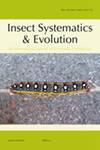来自巴拿马中部的一天闪光的Photinus萤火虫(鞘翅目:Lampyridae):向无捕食者空间的紧急转变?
IF 1.3
3区 农林科学
Q2 ENTOMOLOGY
引用次数: 6
摘要
Photinus属的萤火虫因其夜间发光的求偶表现而备受关注。在这里,我们报道了一种新的萤火虫,Photinus interdius,它以其完全昼夜发光的求爱方式而闻名。雄性慢慢地飞到地面附近寻找可以接受的雌性,并发出800毫秒的明亮的黄色光,每3 - 4秒闪烁一次。男性航班最早于13点10分开始,18点前停止。我们测序了两个线粒体位点和一个基因组位点,并将这些位点与来自45个Photinus和25个相关物种的99个标本的基因组位点相结合。贝叶斯推断得出了一个很好的系统发育结果,即这个新物种是Photinus分支最近的亲戚,但却是Photinus分支的基础。我们认为,这种求爱生态位的特殊时间变化的适应性意义是一种选择性景观的结果,这种景观优化了捕食风险降低和配偶定位容易之间的权衡。本文章由计算机程序翻译,如有差异,请以英文原文为准。
A day-flashing Photinus firefly (Coleoptera: Lampyridae) from central Panamá: an emergent shift to predator-free space?
Fireflies in the genus Photinus are well regarded for their luminescent nocturnal courtship displays. Here we report on a new firefly species, Photinus interdius, which is remarkable for its fully diurnal and luminescent courtship protocol. Males slowly flew near the ground searching for receptive females and emitted 800 ms, bright yellow light flashes at 3–4-s intervals. Male flights occurred as early as 13:10 and ceased before 18:00. We sequenced two mitochondrial loci and one genomic locus and combined these with those from 99 specimens representing 45 Photinus and 25 related firefly species. Bayesian inference resulted in a well-resolved phylogeny that placed this new species as the closest relative of, but basal to the Photinus clade. We propose that the adaptive significance of this extraordinary temporal shift in courtship niche is the outcome of a selective landscape that has optimized the trade-off between reduced predation risk and ease of mate-localization.
求助全文
通过发布文献求助,成功后即可免费获取论文全文。
去求助
来源期刊

Insect Systematics & Evolution
生物-进化生物学
CiteScore
3.00
自引率
0.00%
发文量
15
审稿时长
>12 weeks
期刊介绍:
Insect Systematics & Evolution (ISE) publishes original papers on all aspects of systematic entomology and the evolutionary history of both extant and extinct insects and related groups. Priority is given to taxonomic revisions and phylogenetic studies employing morphological and molecular data. ISE also welcomes reviews and syntheses that can appeal to a wide community of systematic entomologists. Single species descriptions, regional checklists, and phylogenetic studies based on few taxa or single molecular markers will generally not be accepted.
 求助内容:
求助内容: 应助结果提醒方式:
应助结果提醒方式:


